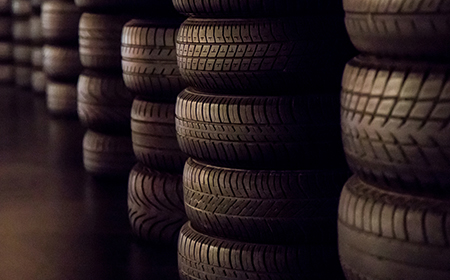A "P" listed in front of the tire size indicates that it is "P-metric" size. P-metric stands for passenger vehicle. Passenger vehicles are cars (for example sedans and coupes), minivans, or CUVs, but can also be trucks that do not carry extra heavy loads or run on gravel roads. If there is no letter in front of the size, then the tire is for passenger cars, and closely equivalent to p-metric. These tires have an internal construction and use materials designed to give a smooth ride, good handling on the highway, and to last a long time.
LT Tires have “LT” in front of the size. They are for heavy loads, towing and off-road durability. They are more expensive than p-metric tires. This is because LT tires have extra material in the sidewall and under the tread that protects the tire from damage. The cords in a LT tire are a larger gauge than P-metric tires so the tire can carry heavier loads. Very often LT tires will have an extra steel belt, a deeper tread and thicker rubber in the sidewall for more protection vs a p-metric tire. LT tires are usually 8-ply (Load Range D) or 10-ply (Load Range E). Passenger Tires usually have a 4-ply or 6-ply equivalent sidewall. The performance trade-offs of the added material in LT tires are harsher ride, less fuel efficiency, and less responsive handling.
Which type of tire is right for you depends on how you use the truck. P-metric tires are perfectly adequate for pick-up truck owners that rarely go off paved roads, carry heavy loads, or tow a trailer. Many half ton trucks come equipped from the factory with p-metric tires for this very reason. If you own a half ton pick-up truck or full-size SUV and rarely if ever carry a load or go off pavement, then a p-metric tire will be a better choice for your replacement tire. They will ride smoother, last longer, and be more fuel efficient than a LT rated tire in the same size.
If your truck, van or full size SUV comes from the factory rated for LT tires, it is best to replace the tires with LT tires. P-metric to LT is acceptable, but never replace original equipment LT tires with P-metric tires due to them having lower load capacity ratings at maximum air pressure.
If you drive your truck heavily loaded or pull heavy trailer loads frequently, you should consider replacing your p-metric tire with an LT tire. Tradespeople that have their truck or van loaded with tools, supplies and equipment often find that the stiffer LT tires means less sway, and therefore better loaded handling. Others may find that the ride is slightly harsher and not as comfortable as p-metric tires. This is one of the trade-offs you can expect when you replace a p-metric tire with a LT tire.
